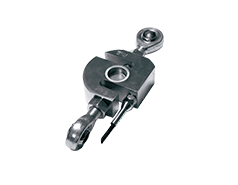Traction Load Cells
A crucial technology for measuring loads
Traction load cells are essential devices in various industries, from manufacturing to logistics, food processing and aerospace. They play a central role in accurately measuring loads, which is essential to ensure safe, quality and efficient operations.
Principles of operation of the Traction load cell:
Traction load cells, also called tension load cells, operate on simple but effective principles. They are designed to measure the traction force exerted on them when loads are suspended from a hook, cable or support. Measuring this force makes it possible to determine the weight of the load with great precision.
How does a traction load cell work?
Traction sensitive elements:
Inside the sensor there are traction sensitive elements, usually strain gauges or tension sensors. These elements are designed to respond to variations in force by changing their electrical resistance.
Application of the load on the traction sensor:
A load is suspended from the traction load cell. When the load is applied, it exerts a traction force on the sensitive elements.
Measurement of deformation on the traction load cell:
Traction sensitive elements deform under the influence of the traction force, which causes a variation in their electrical resistance. This variation is proportional to the force exerted and therefore to the weight of the load.
Conversion to traction sensor measurement:
Load cells are equipped with an electronic circuit that measures the change in resistance and converts it to a weight value, usually using a Wheatstone bridge method. This value is displayed or transmitted to a control or monitoring system.
Common applications with a traction load cell:
Traction load cells find use in a wide range of applications. Here are some of the common applications:
1. Weighing in the food industry
In the food industry, these sensors are used to accurately measure ingredients in production processes. They guarantee compliance with quality and food safety standards.
2.Logistics
Traction load cells are used in warehouses and loading docks to check the weight of packages and goods. This helps ensure products are labeled correctly and calculates shipping costs accurately.
3.Weighing element in construction
In the construction industry, these sensors are used to monitor tension in crane lifting cables, ensuring the safety of heavy lifting operations.
4.Health
In medicine and fitness equipment, traction load cells are used to measure body weight, monitor vital signs, and evaluate athletic performance.
6.Research Laboratories /weighing by measuring the traction force
In research laboratories, these sensors are used to precisely measure forces in scientific experiments, materials testing and mechanical testing.
Importance of Traction Load Cells
Traction load cells play a vital role in many industries due to their ability to provide accurate and reliable measurements. Their importance lies in the following advantages:
1. Measuring accuracy of the weighing sensor
These sensors provide exceptional accuracy in measuring weight, which is crucial for industries such as pharmaceuticals, where the slightest inaccuracy can have serious consequences.
2.Reliability of traction weighing
They are designed to withstand harsh environments and variable loads, making them reliable in a wide variety of applications.
3.Traction weighing sensor safety
In industries where safety is paramount, such as construction and aerospace, traction load cells help ensure safe operations.
4.Quality Control
They help maintain high quality standards by ensuring that products are weighed correctly and measure any overloads.
5.Simplicity and efficiency of implementation
They help in the automation of processes, which results in increased efficiency and reduced human errors.
In conclusion, traction load cells are crucial components in many industries, providing significant benefits in accuracy, reliability, safety and quality control. Their use helps ensure smooth operations and compliance with applicable safety and regulatory standards. These devices play a vital role in the modern world, contributing to the quality and safety of many aspects of our daily lives.
-------------------------------------------------- -------------------------------------------------- ---------------
Special feature of the Traction weighing sensor
- Stainless steel traction sensor (5 tons and 7.5 tons)
- Protection rating IP68
- Approved up to 3,000 d OIML
- For Traction weighing application
Electrical characteristics of the traction sensor:
- Maximum supply voltage: 15 Volts
- Rated sensitivity:
- ZAP 5 tonnes: 2 m V/V
- ZAP 5 tonnes: 2 m V/V
- Input impedance (resistance): 385 Ω ± 20 Ω
- Output impedance (resistance): 350 Ω ± 5 Ω
- Insulation resistance: 5,000 MΩ /50V
Metrological characteristics of the ZAP sensor:
- Rated capacity (Cn): 5 tons, 7.5 tons
- Combined error: ±0.017% Cn
- Maximum supply voltage: 15 Volts
- Compensated temperature range: -10 ... +40 C°
- Zero temperature drift ≤ ± 0.0014% Cn
- Creep (30 min): 0.024% Rated load
- Maximum capacity (Emax): 5000kg, 7,500kg
- Max number of steps (n.max) (d OIML): 3,000
- Min. verification step (Vmin): max/ 10,000 kg
- Z = Emax/ (2xDR): 3,000
Mechanical properties for the Traction load cell:
- Allowable mechanical overload 150% Rated load
- Protection rating IP68
- Material: stainless steel
Example of application for the ZAP Traction weighing sensor:
- Hanging weighted mat
- Suspended hopper weigher
- Traction force measurement
- Weighbridge modernization (sensor at the end of the lever on hybrid weighbridge)
-
More
Traction load cell in stainless steel
Perfect for hanging conveyor belt or hopper and measuring traction effort.




